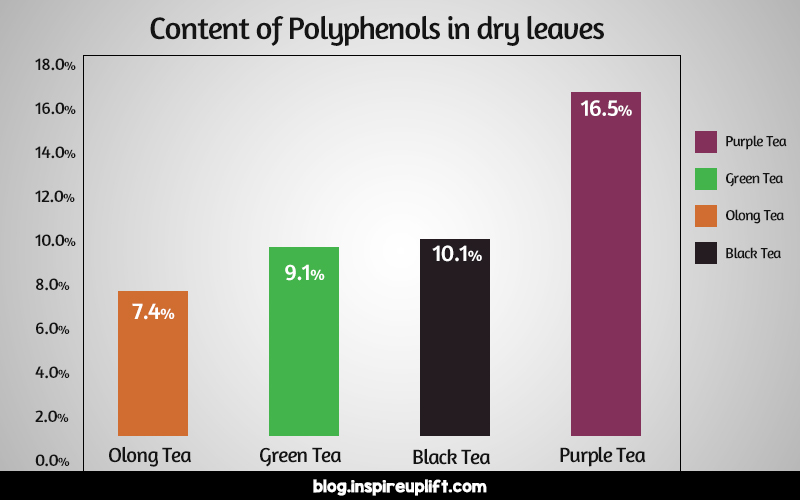Green, Black, Oolong, how many more teas we know of?
Indeed, quite a few, including premium black teas, like Orange Pekoe
Want to know about a tea that has a gigantic amount of 51% antioxidants that can prevent cancer and boosts the brain’s antioxidant capacity?
Even more surprising is the fact that it’s not a new tea. It’s just a premium variety of green tea.
THE PURPLE TEA.
So, without further delay, let’s explore this fantastic tea.
Table of Contents
What is Purple Tea?

Purple tea is the rare variety of tea produced in Kenya, obtained from the same plant, Camellia sinensis, from which black and green teas are obtained.
Its name, purple tea, signifies the color of the leaves that are due to the high-level of anthocyanine in it, a compound that’s rich in eggplant, berries, etc.
And do you know, the agricultural name of the purple tea, as named by the Kenyan Tea Research Institute, is TRFK306?
How does Purple Tea Taste Like?

It tastes sweet, pleasant, and woody, ranked between green and black tea, because it’s a bit lighter than black and bitter than green tea, but without any grassy or vegetable-like flavor that is usually exhibited by green tea.
And even more interesting is the fact that…
This Kenyan purple tea tastes similar to oolong tea, because of being processed the same way, that is, partially oxidizing with leaves rolled.
Origin and Rise of Purple Tea
The purple tea is believed to be originated as wild tea in the Assam state of India. But later, seedlings were transferred to Kenya, and there it started to be cultivated commercially.
And the best thing is,
It’s being promoted heavily by incentivizing the farmers because it’s sold for 3-4 times the price of black tea, thanks to the efforts of the Tea Research Foundation of Kenya, which collaborated public-private partnership for its mutation and mass production.
Quite interestingly,
The farms of purple tea are located some 4500-7500 feet above the sea level, for the conditions required for its growth are ideal at that altitude.
At such a high altitude, the ultraviolet (UV) rays of the sun are highest because cloudless skies and thinner atmosphere filters less UV radiation. Each 100 meters height means a 10-12% increase in UV levels.
And do you know,
The purple color of the leaves is, in fact, a reaction of the plant against the potential damages of UV, by releasing high levels of antioxidants. And this is what makes it special.
India is now trying to get the title back under the authority of the Tocklai Tea Research Institute (TTRI). According to them, Assam has tremendous potential to produce this tea of the future.
Major Constituents of Purple Tea
- Caffeine,
- Theobromine,
- Epigallocatechin (ECG),
- Epigallocatechin gallate (EGCG) and
- 1,2-di-O-galloyl-4,6-O-(S)-hexahydroxydiphenoyl-β-D-glucose (GHG)
Nutritional Facts of Purple Tea
Purple tea has many more nutrients than its counterparts, like green and traditional black tea. The greater number of antioxidants than other teas makes it high-demanding tea. Let’s look at the nutritional benefits of this tea.
- Anthocyanins: This compound is richly present in purple tea, that is, 15 times more than what is present in blueberries even. And this is why its color is purple.
- Antioxidants: It has more antioxidants than green or black tea, as high as 51% as compared to 34.3% in green tea.
- Polyphenols: Purple tea takes the lead in polyphenols as well, with a staggering quantity of 16.5% as compared to 10.1% in black and 9.1% in green tea.

- Some bioactive compounds like EDCG, GHG, Theobromine, Caffeine, and ECG
The benefits we get from the presence of the compounds above are discussed separately below.
Purple Tea Benefits
Although got from the same tea plant, yet the genetic mutation makes it extremely beneficial for health.
Let’s look at each of its benefits.
1. As an Anti-cancer Agent

Followed by green tea, Phytochemicals, and other functional components in purple tea contribute high in the inhibition of cancer cells (4TI) from further proliferation.
Its powerful antioxidant capacity helps to prevent certain types of cancers, including breast, colon, and prostate cancers.
2. Stimulates Immune System

A study has concluded that consuming purple tea regularly helps to stimulate the immune system by creating lymphocytes. Lymphocytes are types of white blood cells that protect you from infectious diseases and cancer cells.
3. Boosts the Brain’s Antioxidant Capacity

A study was conducted to check the role of anthocyanins, which is richly present in purple tea, in boosting the brain antioxidants capacity, if any.
And it was concluded that anthocyanins in purple tea have the capability of crossing the Blood-Brain Barrier (BBB) and reinforce the brain’s antioxidant capacity.
Therefore, purple tea can be used as a tonic for brain health, a benefit that other teas may not be capable of providing.
4. For Hair and Skin Health

The anthocyanin is purple tea is the distinguishing factor of it, which makes it rank higher among all the teas. In addition to the benefits provided by anthocyanin, skin health is yet another feature of it.
According to a study, anthocyanin increases the level of extracellular molecules (ECM), including elastin and collagens.
Purple tea’s antioxidants fight with free radicals and toxins in your body that otherwise can damage collagen and elastin, resulting in acne scars and dead skin.
Also, its extracts are used to treat baldness as it helps to increase blood circulation in the scalp. There are a number of shampoos, toners, gels and serums, and hair massage brush types that make use of purple tea.
5. Stress and Anxiety Relieving

Like other teas, caffeine in purple tea can help reduce stress and anxiety. A study shows that purple tea extracts have anti-anxiety and anti-depressive properties.
Drinking it more frequently reduces physical and mental exhaustion that makes us less prone to external stress.
6. For Diabetes

Purple tea is also helpful in reducing the blood sugar level if taken twice a day. The antioxidants and phenols in it are effective for patients having type 2 diabetes.
7. For Weight Loss

Weight loss property of green tea is well known to everyone for its high amount of antioxidants. But what could do better than a tea that has 1.4 times more antioxidants than green tea?
According to a study, drinking purple tea can significantly reduce one’s weight, and thus possess the best anti-obesity properties ever found in any tea. The study explains that caffeine suppresses fat absorption, and the combination of catechins and caffeine enhances the anti-obesity effects in the body.
Using a fat-burning massager or slimming belly pellet along with purple tea is an ideal combination to fast-track your fitness goals.
8. For Inflammation

Purple tea is also known for its anti-inflammatory properties that help to prevent chronic and acute inflammation. Other benefits include relief from arthritis pain.
Side-Effects of Purple Tea
Few people who consumed purple tea complained of having nausea or diarrhea when they took it too often.
But, the good news is,
The addiction and side-effects that are prevalent in green and black tea are not present in purple tea, thanks to the lower quantity of caffeine and tannin in it.
Can pregnant drink this tea?
Regarding the consumption of purple tea by pregnant women, there’s still a question mark. Since purple tea is relatively new in the market, fewer studies have been conducted so far.
Taking it as a black tea, which in fact, it is, we can follow the same myth. Means, it’s not harmful to pregnant, but, at the same time, should be taken with caution.
How to Make Purple Tea

Having known its benefits, let’s show you how to make this unique yet wonderful tea at home and drink it in one of your favorite unique mugs.
Purple tea is brewed the same way as green, black tea, or cerasee tea.
Ingredients:
- A tea bag or loose leaves of purple tea
- Sugar (brown or white)
- Condensed Milk (optional)
- Boiling water
Directions:
Pour fresh boiling water over the tea bag and brew for 2-3 minutes. But don’t go beyond this time, as unlike other teas, there would develop a strange bitterness.
Alternatively, if you have loose leaves, use tea mug infuser. Finally, sweeten to taste with sugar or honey. The tea is ready! Pour it in your mug and enjoy it.
Different Purple Tea Names Available Commercially
The following list is not exhaustive but differs from producer to producer, most of which are organic purple teas.
- Purple Rain
- Purple Jasmine
- Purple Chocolate
- Purple Mint
- Purple Leaf Tea
The Bottom Line!
Until now, we have been thinking green tea as the best of all the teas, isn’t it? But seeing the benefits of purple tea, it’s time we must try this amazing tea as well.
And do you know the antioxidants are the biggest thing we look for in any tea? No wonder Purple tea has the most antioxidants than any other tea.
Having anthocyanin 15 times more than blueberries even, antioxidants more than green tea, and polyphenols 1.6 times than in green tea is an eloquent testimony to call it the king of all teas. It can be a nice gift to your coffee-loving friend as well.
Which flavor of purple tea have you tried yet? Was it Purple Chocolate or any other? Let us know in the comment section below.

